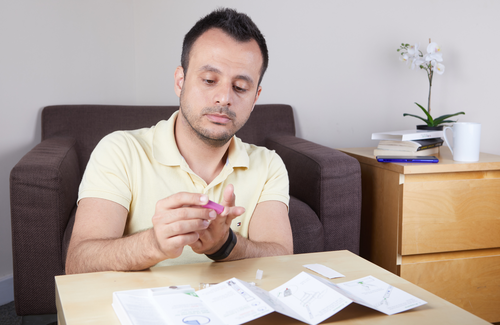
Is using HIV self-tests with sexual partners an appropriate strategy that should be encouraged by health bodies? Could it help people who are already irregular condom users to avoid unprotected sex with people of a different HIV status? Might it enable people with undiagnosed HIV to get tested?
As there are also questions about whether people would be able to handle the situation should the result appear to be HIV positive – and concerns about the potential for partners to be angry or violent – Professor Alex Carballo‑Diéguez and colleagues ran a randomised study in New York City and Puerto Rico, whose results have just been published in a series of papers in AIDS and Behavior.
The project was called 'I’ll show you mine' and explicitly encouraged participants to use OraQuick self-testing kits to test themselves and their sexual partners.
To be eligible, participants had to be a man who has sex with men or a transgender woman who was HIV negative, reported multiple recent sexual partners, did not consistently use condoms, and was not taking PrEP. The 272 participants were ethnically diverse (including 57% Latino and 40% black), mostly in their twenties or thirties, included 10% transgender women, and did not necessarily identify as gay (only 78% did so).
Half the participants were randomised to an intervention group which received ten OraQuick self-testing kits, with the option of requesting further kits if they needed more. They also watched a video that reflected other people’s experiences and suggestions about using the test, covering issues such as how to propose testing to a partner, the need to respect a partners’ decision not to be tested, and partners’ potential reactions. They were told to exercise their best judgement when deciding which partners to ask to test. Participants randomised to the control group did not receive the self-testing kits or watch the video.
For three months, data on HIV testing and sexual behaviour was collected regularly via text messages, with a follow-up visit at the end of this period.
How the tests were used
Of the 136 people who received the self-testing kits:
- 100 tested themselves (although all had just tested HIV negative, as part of the study procedures).
- 71 proposed using the test with at least one potential partner while communicating on a dating app or phone.
- 111 proposed using the test with at least one potential partner when they were together, with requests made to a total of 870 potential partners.
Tests weren’t used with all partners – 79 participants said they sometimes didn’t request a test, most often because they didn’t have the test kit with them, because they thought the partner was HIV-negative, because they felt uncomfortable bringing up the test, because they thought it might bring the sexual encounter to an end, or because they weren’t planning to have anal sex.
Forty-one people had at least one person refuse to test, but this did not necessarily stop sex from happening. In fact, 18 participants went on to have condomless sex with a person who had refused to test.
The primary outcome of the study was the number of times the participants had had condomless anal sex with a partner whose HIV status was unknown or positive in the previous three months. The average number was 21 in the intervention group and 31 in the control group, suggesting that the intervention might have helped participants avoid some risky situations. However, the difference was not quite statistically significant (rate ratio 0.68, 95% CI 0.45-1.05).
Not all potential partners responded well to the suggestion of testing. Of the 870 partners, 113 became angry or upset, including 16 who became physically violent. These incidents – none of which resulted in serious injury – usually occurred at the time of suggesting the test, rather than after reading the results.
At the follow-up assessment, the participants who received self-tests were asked whether they felt able to handle these situations. Twenty-two per cent said that it had sometimes been hard to judge whether a partner could become violent, 7% said it had been hard to avoid violent situations and 6% said it had sometimes been hard to handle a violent situation.
"The researchers hope that using self-tests with partners will have decreased the risk intrinsic in relying on intuition or what a partner says about their HIV status."
The authors do not believe that these “very limited” violent reactions undermine the case for testing sexual partners.
A potential harm that the studies do not have data on is people using false negative results to guide a decision to have sex without condoms. As the researchers set out to recruit people from communities with a high incidence of HIV, it’s likely that some people had very recently acquired HIV. OraQuick is a second-generation test with a window period of between one and two months, so people exposed to HIV in that time frame might not get an accurate result.
But given the existing sexual behaviour of participants, it’s also likely that a proportion would have had condomless sex anyway. The researchers hope that using self-tests with partners will have decreased the risk of relying on intuition or what a partner says about their HIV status.
Handling positive results
Fourteen of the participants had a partner who received a reactive (preliminary HIV positive) test result, with this happening to a total of 24 partners. They were equally likely to be new partners or fuck buddies (none were lovers or primary partners). These tests usually happened in the participant’s or their partner’s home, with three happening in a hotel or car.
On a scale of 1 (not stressful at all) to 10 (extremely stressful), participants gave these incidents an average rating of 6.4.
Asked about confirmatory testing, the study participants said that they thought 12 partners had gone for testing and three partners had not, with the outcome unknown for the others.
In-depth interviews with ten of these participants whose partner received a reactive result showed that most were able to handle the situation. Partners who were surprised by the results were often distressed and became sad or nervous, as these participants explained:
“He got tearful. He got frustrated. He did not get violent. He did not want to continue spending time with me. He just shut down. He just told me that it was better I take him home.”
“So, we was basically talking about his testing results, and then, I went over, I looked at it, and then, he was like, 'Is something wrong?' So I was like… 'You want to look at this?' And he looked at it. And this was, like, mad awkward. For like about a good two, three minutes, it was awkward. It just felt funny. It was silent.”
Some partners questioned the validity and reliability of the test. Two became angry but none were violent.
“When she finally took it and it came back positive I’m like, 'Oh, you positive. You need to go see a doctor or go get checked up or whatever.' [She was] Like, 'Who the fuck are you?' 'Who are you working for?' thinking I’m from the health department or some type of snitch.”
For some other partners, the result confirmed their intuition that they were living with HIV. Some others had already been diagnosed but the self-test facilitated disclosure to the study participant. While some of the participants were supportive, others felt that they should have been told earlier, for example by an ongoing partner (fuck buddy).
In general, participants were supportive and tried to be helpful when their partners got a reactive result:
“I told him 'look, let’s re-do the test so that you’ll be calm.' He re-did the test and it came out the same. But before doing the second test, I had already given him a list of telephone contacts in case it came out positive. I asked him if I could stay in touch to know his status, to ask how he was doing. He said yes, but never answered my calls. I was very sad about it because he was a really nice guy.”
For many interviewees, the reactive result served to halt the sexual encounter. In other cases, generally between fuck buddies, sex resumed at a later date, or there was intimacy of a different nature:
“We cuddled more than we had sex, more so. I mean, was there penetration? Slight, but – it was with a condom and lube. But we just cuddled more.”
Carballo‑Diéguez and colleagues believe their findings support the feasibility of the intervention: “Our findings demonstrate that [participants] can be motivated to use self-testing with partners, succeed in convincing their partners to use self-testing, encounter very limited violent reactions, and identify previously undetected infected individuals. In such cases, individuals are able to deal with partners’ positive self-test results satisfactorily.”
Carballo‑Diéguez A et al. Use of Rapid HIV Self-Test to Screen Potential Sexual Partners: Results of the ISUM Study. AIDS and Behavior, online ahead of print, December 2019.
doi: 10.1007/s10461-019-02763-7
Carballo‑Diéguez et al. Few Aggressive or Violent Incidents are Associated with the Use of HIV Self-tests to Screen Sexual Partners Among Key Populations. AIDS and Behavior, online ahead of print, February 2020.
doi: 10.1007/s10461-020-02809-1
Balán IC et al. Then We Looked at His Results: Men Who Have Sex With Men from New York City and Puerto Rico Report Their Sexual Partner’s Reactions to Receiving Reactive HIV Self-Test Results. AIDS and Behavior, online ahead of print, February 2020.
doi: 10.1007/s10461-020-02816-2

